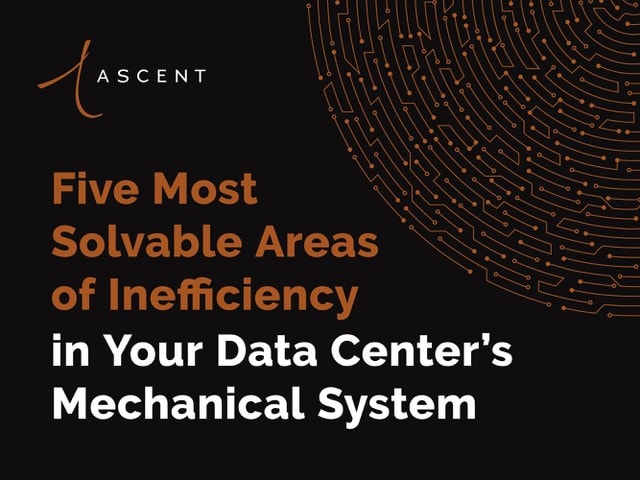Without a doubt, typically the largest opportunity for energy savings in a data center facility is found within its mechanical system. While it is easy to become inundated with the array of critical equipment’s latest green features, the reality is that the overwhelming emphasis on energy savings in existing operational facilities should be on the delivery of air to—and the rejection of heat from—the IT load.
Careful operation of these systems is paramount to minimizing carbon footprint and should be monitored daily and weekly. Small changes over time can introduce inefficiencies into the mechanical system, resulting in increasingly large losses in both energy and capital.
The most common inefficiencies we outlined in a multi-year study are solvable when evaluated by experienced engineers and addressed through operational practices. The top five include:
- Unmanaged supply airflow delivery losses: Efficiently delivering supply airflow to the load is the first step in the cycle of mechanical efficiency. Recommendations: install blanking plates on open RU’s in cabinets, seal floor openings, and install brush-style air guards on cable cut outs.
- Supply-to-load airflow capacity losses: Another part of efficiency on the supply side is ensuring that the supply air is matched to the load. Recommendations: relocate, remove, damper, and replace floor airflow tiles throughout the data center to only supply the proper amount of air to the cabinet load, cabinet by cabinet.
- Production of too much supply airflow relative to the load: When supply airflow is not adequately managed, it is easy to lose sight of the fact that excess energy is being expended, much like placing a bed over a home air-conditioning duct. Recommendations: evaluate shuttering CRAH units to decrease energy consumption and provide opportunities to increase redundancy of the air-delivery system.
- Return set points too low and humidity set points too high: When air-handling units are not operating within their optimal ranges, this leads to inefficiencies. The primary objective is to deliver supply air to the IT loads within ASHRAE recommendations of 64-81°F and targeting a 20°F temperature differential between supply and return air. The higher the operating temperatures and closer to a 20°F delta T, the more efficient the system will operate. The common challenge to achieving efficiency is how to control the HVAC systems, and whether the existing controls are reading supply air or return air conditions. Humidity control is similar. Relative Humidity (RH) is best converted to dew point control and maintained on the lower end of the ASHRAE recommendations of 15.8-59°F dewpoint. When properly evaluated by engineering, most times the usage of humidifiers and reheat within the HVAC systems is significantly reduced or eliminated, resulting in both energy and water savings.
- Economizer modes: Many existing sites are already equipped with some form of economizer modes for HVAC and even UPS operating modes. The issue is that some modes are often found disabled as they could introduce operational risk, but engineering resources focused on data center operations can help navigate that risk. An operations engineer can recommend site-specific operational and training program changes to either activate existing economizer modes available at a data center, and/or recommend the best path(s) to prepare to operate in economizer modes with a payback analysis to make sure it makes sense for your operation.
The mechanical systems in the facilities studied are not necessarily built with inefficiencies, nor are they designed incorrectly. Rather, mechanical systems tend to slowly fall into a state of inefficiency over time with moves, adds, and changes in the data center, and can be remedied through the application of established operational best practices for optimizing supply and return airflow.
To learn how to address inefficiencies in your facility’s mechanical system, head to the Facility Evaluation solutions and services page on our website. You can also contact our team directly to learn more about facility evaluation services at 1.877.427.2368, or email us at answers@ascentcorp.com.
